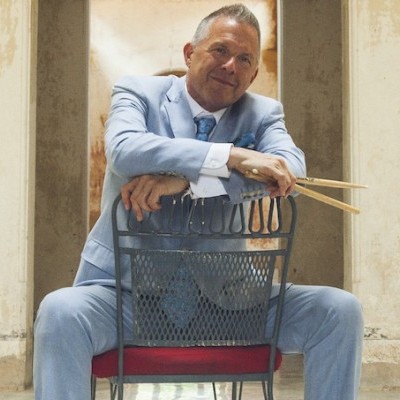Oct 28, 2025 10:47 AM
In Memoriam: Jack DeJohnette, 1942–2025
Jack DeJohnette, a bold and resourceful drummer and NEA Jazz Master who forged a unique vocabulary on the kit over his…

Singer Kurt Elling, seen here performing at the 2018 North Sea Jazz Festival, also participated in a DownBeat Blindfold Test during the fest.
(Photo: North Sea Jazz Festival)Kurt Elling’s new album, The Questions (OKeh), is more evidence of his stature as one of the top vocalists in jazz. During Elling’s performance at this summer’s North Sea Jazz Festival, he won over the audience with his mastery of vocalese and emotionally expressive delivery. The following live Blindfold Test with Elling was a separately staged event that took place in front of a North Sea audience on July 13. (DownBeat also conducted Blindfold Tests at North Sea with Jazzmeia Horn and Vijay Iyer.)
Joe Williams, Lambert, Hendricks & Ross
“Goin’ To Chicago” (The Jazz Singers: A Smithsonian Collection Of Jazz Vocals From 1919 To 1994, Smithsonian 1998, rec’d 1958) Williams, David Lambert, Jon Hendricks, Annie Ross, vocals; Count Basie, piano; Thad Jones, Snooky Young, Wendell Culley, Joe Newman, trumpet; Henry Coker, Al Grey, Benny Powell, trombone; Marshall Royal, Frank Wess, alto saxophone; Billy Mitchell, Frank Foster, tenor saxophone; Charlie Fowlkes, vibes; Freddie Green, guitar; Eddie Jones, bass; Sonny Payne, drums.
That’s Lambert, Hendricks & Ross with the Count Basie Orchestra and the great Joe Williams. I better know that. We lost Jon last year. He was a friend, a mentor, a hero and an instructor. He was a beautiful gift to me. There was a high level of art to what he brought as a performer, a high level of charisma in his stage presence. He left nothing untouched, as far as what jazz singers can do. This tune is dear to my heart, because I got to record it with Jon. That was another gift from him in that he agreed to do that. He was conscious of and interested in the fostering of the legacy. I’m happy and proud to do what I can to encourage that movement forward in time. I didn’t hear this music as a child. I discovered Lambert, Hendricks & Ross in college. I thought, “How are they doing this? Where are all the melodies coming from? How does Jon know how to sing all these things?” It was mesmerizing to me. It wasn’t until I went backward and started listening to the instrumental versions that I understood. From that day on, I started to do something like that in my writing tasks.
Allan Harris
“I’ve Got The Blues (Lester Leaps In)” (Black Bar Jukebox, Love Production Records, 2014) Harris, vocals; Pascal Le Boeuf, piano, keyboards; Yotam Silberstein, guitar; Leon Boykins, bass; Jake Goldbas, drums; Samuel Torres, percussion.
Allan Harris is singing a great vocalese piece by Eddie Jefferson. Allan is a friend, and I’m happy that he has made an album of Eddie Jefferson music. He does a perfect delivery, and he has the right sense of humor. He also has the vocal similarities. Bravo. It’s a worthy cause for anybody to keep vocalese alive and moving forward. Anyone who does that is a friend in my book.
Elvis Costello
“Weird Nightmare” (Hal Willner Presents Meditations On Mingus, Columbia, 1992) Costello, vocals, harmonic canon; Michael Blair, cloud chamber bowls; Marc Ribot, marimba eroica; Don Alias, bass marimba; Henry Threadgill, flute; Art Baron, great bass recorder, trombone; Greg Cohen, bass; Bill Frisell, guitar; Francis Thumm, chromelodeon II.
Scary. Elvis Costello as it could only be. It’s a strange little number. I wonder how many times people would actually listen to a tune like that? It’s one thing trying to hear it one time, and it’s interesting and it’s spooky. I can see if you want to go down that road, if you’ve got those lyrics and that melody and that compositional sensibility of Mingus. Was this for a soundtrack? People always want to try out different things, but how different do you need to make something Mingus wrote to make it effective? Also, my question would be: Do your ideas make the expression more emotional? Does it make the delivery of the music more emotional? Or is this an intellectual exercise or a math exercise or a technology exercise to make all these crazy sounds? On an emotional level, this doesn’t touch me. I can’t imagine that it would be important for me to hear this a second time.
“Cru-Cre Corroro—Brand New Samba” (Awa Yio, Reprise, 1991) Lins, vocals, keyboards; Larry Williams, keyboards; Heitor T.P., guitar; Tony Levin, bass; Vinnie Colaiuta, drums.
This isn’t in my wheelhouse. I can’t say who the singer is. There’s a whole world out there that I need to continue to explore. Compositionally, it’s a lot of fun and whoever is singing has a great voice. But this track is too overproduced for my taste. It’s just too clean in every way. They took the spirit out of how that music should feel when it’s so free. If you’re going to have a big party with a bunch of people singing along and let it happen that way, everyone listening can get into that spirit. But it’s just too perfect, too clean. There are no mistakes anywhere, and that’s not the way that jazz and samba are. The music of the people is interactive and it has warts and cuts and bruises and mistakes. [after] Oh, it’s Ivan Lins? I should have known that. He’s a beautiful cat and an incredible writer. When he actually sings and it’s not all fixed up and perfect like that, you can hear the tremolo in his voice, even if he doesn’t hit all the notes. It’s human. It‘s real.
Vince Bell
“Where The Wind Sleeps” (Ojo, Mulatta, 2018) Bell, vocals, spoken word; Renaud-Gabriel, bass clarinet; David Mansfield, banjo.
That’s cool. I feel like I should know his voice from somewhere. Is he the writer? It’s got a great sound, and he’s killing it. But I don’t have any idea. But you can tell he’s the guy who wrote it because all the feeling is there. That’s what you want. If you’re going to tell a story on a recording, it has to have a vibe. It needs the vibe more than anything else. With Ivan Lins, all that vibe was taken out. It was just too perfect and clean and crispy. This guy delivers that emotional content along with the intellectual content of the story he’s telling. It sounds great. I love the bass clarinet. That’s always a good move. You don’t hear a lot of banjo these days, so that’s an interesting moment. Maybe this is more of a folk recording of some kind, but the bass clarinet puts it into any category. [after] Vince Bell? Don’t know him, but he sounds good. I like his voice, and he knows the sound he wants. He’s obviously listened to the great storytellers because he’s getting the emotional content across. I’d rather have him do voiceovers for car commercials than all the guys you hear today.
José James
“Sword + Gun” (No Beginning No End, Blue Note, 2012) James, Hindi Zahra, vocals; instrumentalists unlisted.
It’s José James. I feel like he’s been looking for the right direction for what his voice is. His voice is the coolest. He’s made several different records that have gone in several different directions, and he’s capable of being the best at doing what he wants. I haven’t heard this, but I feel this is a successful direction for him. We’ve done a couple of things together, and his voice is so recognizable. I’m glad to hear him recording this piece, and I would say that maybe he should do some Oscar Brown Jr. I love the drumming vibe here, but I don’t know if it’s jazz. But it’s good music, which is not a strike against it.
Junior Wells
“Stop Breaking Down” (South Side Chicago Blues: Delmark 50th Anniversary Collection, Delmark, 2003, rec’d 1970) Wells, vocal, harmonica; Buddy Guy, Louis Myers, guitars; Otis Spann, piano; Earnest Johnson, bass; Fred Below, drums.
This is a hometown hero from Chicago. It has to be Junior Wells, singing and playing the harmonica. That’s got to be Buddy Guy, too. It’s not jazz, but it is the blues. Junior Wells is one of the definitive sounds to come out of Chicago—both as a singer and a harmonica player. I actually opened up a concert for him when I was still in college. That billing didn’t make any sense. We did our 45-minute set of standards, and then he came out and burned the house down. After that, I’d see him at different blues clubs in Chicago and got to shake his hand. He’s the perfect example of a musician who didn’t clean his recorded music. The cats come and play, and that’s the way it sounds. So, what you get is the way it is. And I approve. Junior Wells is the sound of the blues. What’s not attractive about that? It speaks to everyone in the world. It’s the sound of the heart wide open—the sound of damage and recovery, the spirit awakening or weeping or laughing or moaning. It’s the human sound. DB

Jack DeJohnette boasted a musical resume that was as long as it was fearsome.
Oct 28, 2025 10:47 AM
Jack DeJohnette, a bold and resourceful drummer and NEA Jazz Master who forged a unique vocabulary on the kit over his…

Always a sharp dresser, Farnsworth wears a pocket square given to him by trumpeter Art Farmer. “You need to look good if you want to hang around me,” Farmer told him.
Sep 23, 2025 11:12 AM
When he was 12 years old, the hard-swinging veteran drummer Joe Farnsworth had a fateful encounter with his idol Max…

D’Angelo achieved commercial and critical success experimenting with a fusion of jazz, funk, soul, R&B and hip-hop.
Oct 14, 2025 1:47 PM
D’Angelo, a Grammy-winning R&B and neo-soul singer, guitarist and pianist who exerted a profound influence on 21st…

Kandace Springs channeled Shirley Horn’s deliberate phrasing and sublime self-accompaniment during her set at this year’s Pittsburgh International Jazz Festival.
Sep 30, 2025 12:28 PM
Janis Burley, the Pittsburgh International Jazz Festival’s founder and artistic director, did not, as might be…

Jim McNeely’s singular body of work had a profound and lasting influence on many of today’s top jazz composers in the U.S. and in Europe.
Oct 7, 2025 3:40 PM
Pianist Jim McNeely, one of the most distinguished large ensemble jazz composers of his generation, died Sept. 26 at…